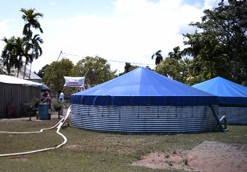Treatment options for water emergencies
The purpose of water treatment in emergency situations is the same as it is in any circumstance, which is to remove all types of contaminants present in the water and to improve the quality to a level safe for human consumption. The difference in emergency situations is that the normal structures and processes are not available.
In acute emergency situations where speed of providing water for people is paramount, the main options for water supply are distribution of safe water to people through the use of water tankers and/or plastic bottles. The other option is to give the water consumers the means of treating water for themselves to render it safe. You learned about the methods that could be used in Study Session 10.
Briefly describe the main processes of household water treatment and give examples of the methods that could be used.
The main processes are sedimentation or filtration, both of which remove solids, and disinfection to kill pathogens. Some examples of filtration methods are cloth filtration, sand filtration, and ceramic filtration. For disinfection methods you could have said boiling, solar disinfection, and chemical disinfection using products such as Wuha Agar, Bishan Gari, Aquatabs and P&G Purifier of Water.
If it is not possible to filter the water, and if the water treatment chemicals mentioned above are not available, then the water should be kept in a container to settle any solids and then decanted out. The decanted water should then be boiled.
Water treatment and distribution
For the longer-term needs of displaced people and refugees, the population should, if possible, be located in an area where there is adequate groundwater. This type of water normally requires minimal treatment before consumption – usually just disinfection, in order to keep the water safe from microbial contamination. Failing this, surface water from rivers or lakes can be used, but these waters will require a greater degree of treatment, since the level of suspended solids in them is likely to be high. Disinfection will again be needed.
One way of achieving this is with an emergency water treatment system that replicates the processes of a full-scale permanent water treatment works. A relatively simple process for emergency water treatment is available (Figure 14.8) and can be constructed in a matter of a few hours (Oxfam, 2014a). The tanks can be set up and operated by a team of seven (an experienced water engineer and six technicians). It is important for sustainability in an emergency that simple systems are used.

Figure 14.8 Emergency water treatment tanks.
In this system, the raw water is dosed with aluminium sulphate coagulant (which is easily obtained in most countries of the world) and left to flocculate and settle for six hours in 45-m3 sedimentation tanks. It is then chlorinated (using a solution of calcium hypochlorite) and sent with a residual chlorine level of about 0.5 mg per litre (0.5 mg l–1) to the distribution system made up of PVC pipes laid above ground (to bury them would take time) and standpipes. The treatment system can produce 180 m3 of clean water a day. Once a week or so, the residual chlorine level is increased to 1 mg l–1 so that the water containers used by the people are disinfected.
How many people could 180 m3 of water support per day, if the water requirement is 20 litres per person per day?
180 m3 is 180,000 litres. If one person needs 20 litres of water a day, 180 000 litres will be enough for (180,000 / 20) = 9000 people.
A more complex water treatment system (Figure 14.9), which uses coagulation and flocculation, sand filtration, microfiltration (where a membrane filters out particles which are 0.05–0.5 µm in size) and chlorination, is available (Oxfam, 2014b). This requires a team of three – an experienced water engineer and two technicians. The unit can produce up to 4 m3 of clean water an hour.

Figure 14.9 A complex water treatment system incorporating many processes in compact units, for use in water emergencies.